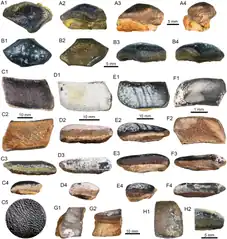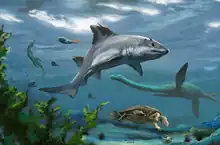Strophodus
Strophodus is an extinct genus of hybodonts known from the Triassic to Cretaceous. It has heavily rounded, durophagous teeth. It has long been confused with Asteracanthus due to the fin spines of the latter being found associated with the teeth of Strophodus. However, both genera can now be reliably be distinguished base on the morphology of both the fin spines and teeth.[1] It was one of the largest hybodontiforms that has ever lived, reaching up to 3 metres (9.8 ft) in length[2]
| Strophodus Temporal range: | |
|---|---|
 | |
| Teeth of Strophodus from the Early Cretaceous of Colombia | |
 | |
| Life restoration | |
| Scientific classification | |
| Domain: | Eukaryota |
| Kingdom: | Animalia |
| Phylum: | Chordata |
| Class: | Chondrichthyes |
| Order: | †Hybodontiformes |
| Family: | †Acrodontidae |
| Genus: | †Strophodus Agassiz, 1838 |
| Species | |
Ecology
Strophodus has been intepreted as a bottom-dwelling animal that fed on hard-shelled invertebrates, though isotopic evidence has suggested that it may have been pelagic. It may also have been euryhaline.[2]
Species
After[1]
- S. reticulatus Agassiz, 1838 Middle-Late Jurassic (Bathonian–Tithonian) England, France, Germany, Hungary and Switzerland. A similar form S. cf. reticulatus is known from the Middle Triassic of Switzerland
- S. atlasensis Middle Jurassic (Bajocian), Morocco[2]
- S. smithwoodwardi (Peyer, 1946) Early Jurassic (Toarcian) Switzerland
- S. dunaii (Szabó & Főzy (2020) Middle Jurassic (Aalenian), Hungary
- S. tenuis Agassiz, 1838 Middle Jurassic (Aalenian-Bathonian) Germany, England
- S. longidens Agassiz, 1838 Middle Jurassic (Bathonian) France
- S. magnus Agassiz, 1838 Middle Jurassic (Bathonian) France, India, England
- S. indicus (Sharma & Singh, 2021) Middle Jurassic (Bathonian), India
- S. jaisalmerensis (Kumar et al., 2021) Middle Jurassic (Bathonian) India
- S. medius (Owen, 1869) Middle Jurassic (Bathonian-Callovian) India, France, England
- S. subreticulatus (Agassiz, 1838) Late Jurassic (Kimmeridigan) Switzerland
- S. udulfensis (Leuzinger et al., 2017) Late Jurassic (Kimmeridigan) Switzerland ?England
- S. tridentinus (Zittel, 1870) Late Jurassic (Tithonian) Italy (possibly a nomen dubium)
- S. rebecae Carrillo-Briceño & Cadena, 2022 Early Cretaceous (Valanginian-Hauterivian), Colombia
Indeterminate remains of Strophodus possibly extend into the Albian stage of the Early Cretaceous. Claimed records of the genus from the Late Cretaceous are doubtful.[1]
References
- Carrillo-Briceño, Jorge D.; Cadena, Edwin-Alberto (2022-06-02). "A new hybodontiform shark (Strophodus Agassiz 1838) from the Lower Cretaceous (Valanginian-Hauterivian) of Colombia". PeerJ. 10: e13496. doi:10.7717/peerj.13496. ISSN 2167-8359. PMC 9167585. PMID 35673391.
- Stumpf, Sebastian; Kettler, Christoph; Kindlimann, René; Cuny, Gilles; Kriwet, Jürgen (December 2023). "The oldest Gondwanan record of the extinct durophagous hybodontiform chondrichthyan, Strophodus from the Bajocian of Morocco". Swiss Journal of Palaeontology. 142 (1). doi:10.1186/s13358-023-00270-w. ISSN 1664-2376.